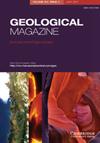西藏羌塘地体南部Rena-Co地区早白垩世火山岩成因:锆石U-Pb年代学、岩石化学和Sr-Nd-Pb-Hf同位素特征证据
IF 2
3区 地球科学
Q3 GEOSCIENCES, MULTIDISCIPLINARY
引用次数: 1
摘要
班公-怒江洋俯冲作用在青藏高原地质演化中具有重要意义。本文报道了西藏中部羌塘地体(QT)南部Rena-Co地区(RCA)早白垩世英安岩的锆石U-Pb年龄和Lu-Hf同位素、全岩元素和Sr-Nd-Pb同位素的新数据,并利用这些数据更好地了解班公-女江缝合带的构造演化。锆石LA-ICP-MS测年结果显示,锆石年龄为109.5±0.6 Ma ~ 109.6±0.8 Ma。地球化学特征为中钾钙碱性英安岩,SiO2含量高,为64.79 ~ 70.37 wt.%, Sr含量高,为517 ~ 598 ppm, Y含量低,为8.45 ~ 10.7 ppm,与典型埃达岩相似。轻稀土元素和部分大离子亲石元素(Rb、U、K、Cs)富集,而高场强元素(Nb、Ta、Ti)富集,符合俯冲带弧型岩浆的地球化学特征。类埃达岩英安岩的全岩初始(87Sr/86Sr)i比值为0.705119 ~ 0.705491,(206Pb/204Pb)i比值为18.489 ~ 18.508,(207Pb/204Pb)i比值为15.591 ~ 15.612,(208Pb/204Pb)i比值为38.599 ~ 38.686,ϵNd(t)值为−0.28 ~ +1.25,单期Nd模式年龄为642 ~ 818 Ma,锆石ϵHf(t)值为3.9 ~ 13.1,年轻贫铪地幔年龄为331 ~ 923 Ma。这些地球化学和同位素资料表明,它们极有可能来自岩浆源区含有交代橄榄岩部分熔体和俯冲相关流体的幼年增厚基性下大陆地壳。综合前人研究和新资料,我们认为RCA埃达克岩样英安岩极有可能是早白垩世班公-怒江洋岩石圈在南QT下向北俯冲的结果,而板块回滚模式可以解释RCA埃达克岩样英安岩的形成。本文章由计算机程序翻译,如有差异,请以英文原文为准。
Petrogenesis of Early Cretaceous volcanic rocks from the Rena-Co area in the southern Qiangtang Terrane, central Tibet: evidence from zircon U-Pb geochronology, petrochemistry and Sr-Nd-Pb–Hf isotope characteristics
Abstract The subduction of the Bangong–Nujiang Ocean is important in the geological evolution of the Tibetan Plateau. In this paper, we report new zircon U-Pb age and Lu-Hf isotopic data and whole-rock elemental and Sr-Nd-Pb isotopic data for Early Cretaceous dacites from the Rena-Co area (RCA) in the southern Qiangtang Terrane (QT), central Tibet and use these data to better understand the tectonic evolution of the Bangong–Nujiang suture. LA–ICP-MS dating of zircons yields ages of 109.5 ± 0.6 Ma to 109.6 ± 0.8 Ma for the dacites from the RCA. Geochemically, these dacites are medium-K calc-alkaline and show high SiO2 contents of 64.79–70.37 wt.%, high Sr contents of 517–598 ppm and low Y contents of 8.45–10.7 ppm, similar to those of typical adakites. Additionally, all the rocks are strongly enriched in light rare earth elements and some large ion lithophile elements (e.g. Rb, U, K and Cs) but significantly depleted in high-field-strength elements (e.g. Nb, Ta and Ti), consistent with the geochemical characteristics of arc-type magmas formed in the subduction zone. Moreover, these adakite-like dacites show whole-rock initial (87Sr/86Sr)i ratios of 0.705119 to 0.705491, (206Pb/204Pb)i ratios of 18.489 to 18.508, (207Pb/204Pb)i ratios of 15.591 to 15.612, (208Pb/204Pb)i ratios of 38.599 to 38.686, ϵNd(t) values of −0.28 to +1.25 and single-stage Nd model ages of 642 to 818 Ma, as well as significantly positive zircon ϵHf(t) values of 3.9–13.1, with young Hf-depleted mantle ages of 331 to 923 Ma. These geochemical and isotopic data indicate that they are most likely derived from the juvenile thickened mafic lower continental crust, which contains partial melts of metasomatized peridotite and subduction-related fluids in the magma source region. Based on previous studies and our new data, we propose that the RCA adakite-like dacites are most likely a result of the northwards subduction of the Bangong–Nujiang Ocean lithosphere beneath the southern QT during the Early Cretaceous and that a slab rollback model could explain the formation of the RCA adakite-like dacites.
求助全文
通过发布文献求助,成功后即可免费获取论文全文。
去求助
来源期刊

Geological Magazine
地学-地球科学综合
CiteScore
4.70
自引率
0.00%
发文量
111
审稿时长
3 months
期刊介绍:
Geological Magazine, established in 1864, is one of the oldest and best-known periodicals in earth sciences. It publishes original scientific papers covering the complete spectrum of geological topics, with high quality illustrations. Its worldwide circulation and high production values, combined with Rapid Communications and Book Review sections keep the journal at the forefront of the field.
This journal is included in the Cambridge Journals open access initiative, Cambridge Open Option.
 求助内容:
求助内容: 应助结果提醒方式:
应助结果提醒方式:


